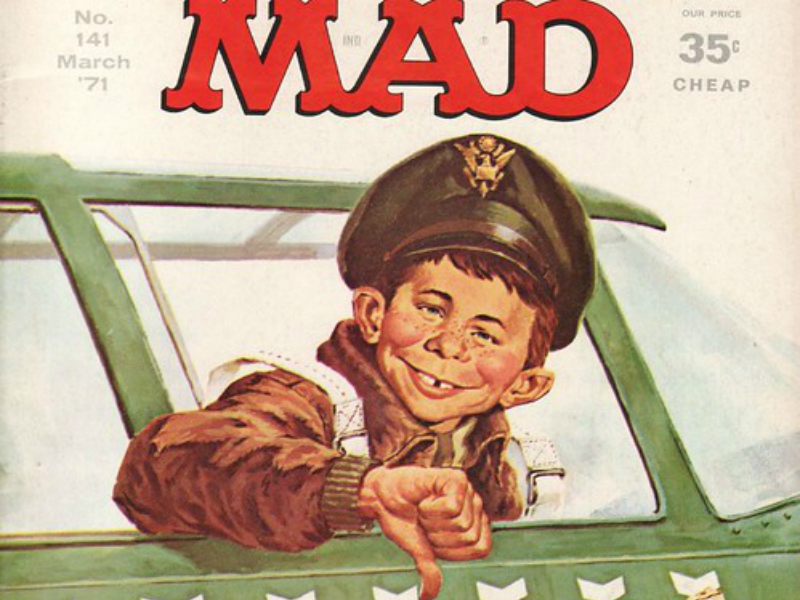I have delivered many a eulogy for recently departed comedians, but this may be the first time I’m doing so for a comedy institution.
Last month, Mad magazine announced it would be ceasing publication, after 67 continuous years. Along the way, there were Mad paperbacks, Mad records, the Mad TV show, even a Mad Broadway show. But none of these ancillary projects had the impact of the original magazine.
The magazine was launched almost by accident. Harvey Kurtzman and Bill Gaines owned a small comic book company, EC Comics, which produced various horror titles aimed at the young teen market. But these comics were very violent, even by today’s standards, and attracted the attention of the U.S. government, which formed a Senate subcommittee designed to stamp out violent imagery in the comic book industry.
Anticipating a crackdown, Kurtzman and Gaines pivoted to a humour publication that would be of no interest to the authorities. Of course, as it turned out, Mad was more subversive than the offensive comics could ever be.
When Kurtzman left in 1956, he was replaced by Bill Feldstein, the roly-poly, bearded troublemaker who would be the driving force behind the magazine for many decades. Under Feldstein, the magazine began to find its way. Movies, TV shows and Broadway plays were parodied. Social mores, especially the conformity of the new suburban lifestyle, were lampooned. All in the user-friendly comic book format that even a smart teenager could digest.
Over the following decades, the best comic satirists were hired. They were mostly Jewish Second World War veterans who were cynical and hard-bitten, with no love for America’s traditional institutions. The magazine’s goofy mascot, Alfred E. Neuman, could be morphed into whatever character was being skewered, including, recently, U.S. President Donald Trump.
New bits were constantly being added, including the back page “fold-in,” a swipe at Playboy magazine’s nude foldout. It was usually the thing most readers looked at first, carefully folding the back cover along the dotted lines to reveal a picture quite different from the original. There were bonus flexi discs from time to time, with titles like “It’s A Gas” (a jazz melody punctuated by belches – oh, how my 10-year-old self found that funny!) and “She Lets Me Watch Her Mom and Pop Fight.”
But the best part of the magazine was the cartoonists who made mincemeat out of pop culture every month. One of my favourites was Dave Berg, whose “The Lighter Side Of…” made sport of suburban culture, with his antihero/doppelganger Roger Kaputnik, which predated Jerry Seinfeld’s observational humour by decades. Add to that Don Martin’s slapshtick, Mort Drucker and Al Jaffee’s movie parodies, complete with full song parodies when necessary, and Sergio Trujillo’s Spy vs. Spy series, which was a pointed commentary on the Cold War, and you had a lot of great comedy reading.
Without ads, I might remind you. Wishing to be free of any outside influence or obligation, Mad kept itself free of advertising – a tough business model if there ever was one. The magazine’s readership peaked in 1974 with two million copies sold in one month, but then entered a period of very slow decline.
Nothing lasts forever, but Mad’s decline was hastened by competitors that went further in a culture that became rougher. National Lampoon was founded mid-1970s, with a gentile, wicked-frat-boy country club mentality that included nudity and swearing. Mad outlasted it, but the damage had been done. Uncensored cable TV didn’t help, either. The proliferation of stand-up clubs gave consumers a new place to get their laughs. Maybe worst of all, the original geniuses that started the magazine began to retire or die off, replaced by a second and third wave of creators that just didn’t have the originality of the founding team.
READ: BRESLIN: CAN THE HOLOCAUST EVER BE USED FOR HUMOUR?
If you talk to many comics, they will cite Mad magazine as a major influence, and this is true of me. When I was 10, my cousin Victor gave me a three-year subscription to Mad. I waited with incredible anticipation for the delivery of the next issue. This would have been 1962-1964, arguably the high point of the magazine. After the subscription ran out, I bought the magazine on the newsstand for decades. I can honestly say that nothing was as important in preparing me for a career in comedy as Mad magazine.
I stopped reading it in the mid-’80s, but recently, I bought a copy for my eight-year-old son. We read it together as I explained the targets of the satires. He got it. But he’ll never know the thrill I got every month of opening that package of forbidden fruit that was Mad magazine. RIP.
